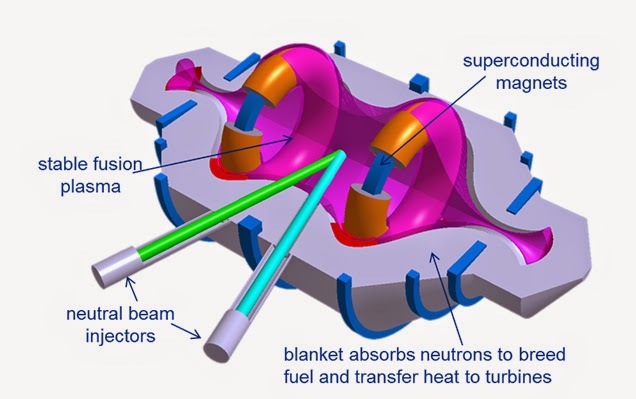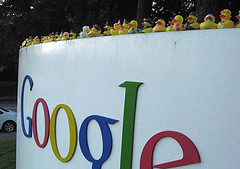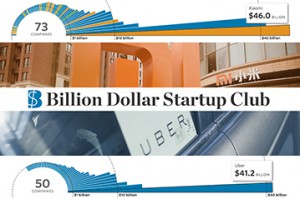new technology
Google says Fi is not intended to disrupt wireless carriers. No one believes it.
Google has just launched Google Fi a wireless service that switches between a carrier network and WiFi depending on signal strength. The launch Google says is not intended to disrupt phone carriers. Which maybe true it is only being rolled out on the Nexus 6 device for now. Yet if this launch is successful it will be easy to see how this can set Google up to enter the carrier market. Priced at $20 a month with a charge of $10 per gb used this would be one of the best priced carrier services especially when you consider the refunds that a consumer would get for unused Data.
As google is already a major player in the phone industry with Android, is this the next major step?
Following the bulls to the bubble?
The billion dollar start up club.
I found this interesting graphic on the Wall Street Journal that got me thinking about start up funding today.
The start up boom is still in full swing and it seems like every time we turn around we are introduced to another billion dollar plus start up. Which begs the questions, are we on our way to the next bubble? Is Uber (valued at $41.2 billion) really worth more then Sony? Is Snapchat, a company that is still not sure how it’s going to make money really worth $15 billion? Are the venture capitalists brilliant or insane?
I don’t believe anyone is sure of the answers to these questions and with so much money on the line it is a safe bet that an army of people are out there somewhere doing the due diligence before handing out capital. I understand that money isn’t just being slung at everyone with a latte and an idea. Indeed start ups are on average getting older and more mature before they head out for a cycle of funding.Yet despite that the spiraling increases in valuation are worrying, they must reach a ceiling at some point. As venture capitalist are still bullish on start ups though its hard to tell if we are in sight of the ceiling yet or still far away.
Here is the article. Are we in the bubble?
Affordable 3D Printing May Be Just Around the Corner

Earlier in the semester when I gave a presentation on 3D printing, I suggested that Consumer 3D Printing won’t be mainstream for another 5-10 years. Well, it looks like it may be here sooner than expected. A team of engineers recently set out to develop a cheap, high-quality consumer 3D printer. With their product, named Tiko, they did just that. Tiko is a 3D printer that is easy to use, non-proprietary, accurate, Wi-Fi enabled, and even comes with its own software to design 3D models on (and be sent right to the printer) — and you can get one for a $179 pledge! This piqued a lot (well, several) peoples’ interest. The group of engineers created a Kickstarter campaign with the goal of raising $100,000 in order to further develop and mass produce the printer. As of now, with 10 days left in the campaign, $2,251,129 has been pledged by 12,663 backers — that is around 178x what they asked for.
As the Kickstarter campaign shows, there is a lot of interest in consumer 3D printing. With Tiko, it looks like it may soon be a reality. I personally think a product like Tiko can make a huge impact, especially in the toy industry. As I mentioned a lot in more presentation earlier in the semester, I think that a company like LEGO should be concerned by the arrival of product like Tiko. If I had one, for example, I could print all of the LEGO pieces that I want, and for much cheaper than buying actual LEGO sets.
What do you guys think, though? Do you guys think this could make a significant impact in the consumer industry, or is it still too early for consumer 3D printing to enter the mainstream market? Let me know what you think!
Why It’s Time To Rethink Your Hospital’s Technology
Hospitals have never promoted a technology forward environment. Is it time for a change? I say yes. With the rise of consumer knowledge through social media, consumers can easily search around for the best price and products. This is no different when it comes to dealing with a hospital. Old IT systems in hospitals today are outdated and lack innovation. We’ve heard some ideas of disruptive innovations when it comes to hospitals in class, but what could a hospital gain from changing its systems to be more productive? What type of changes do you feel would be too drastic that the healthcare industry may not need?
http://www.forbes.com/sites/athenahealth/2015/04/13/why-its-time-to-rethink-your-hospitals-technology/
Lockheed Martin’s Claims Sustainable Fusion is Within Its Grasp

Lockheed Martin Claims Sustainable Fusion is Within Its Grasp
Skunk Works Reveals Compact Fusion Reactor Details
Lockheed Martin’s New Compact Fusion Reactor Might Change Humanity Forever
In February, Lockheed Martin’s Skunk Works team made a bold announcement: they are 5-10 years away from successfully creating and commercially selling compact fusion reactors (CFRs). These devices are conceptually safer, cleaner, and more powerful than much larger nuclear systems that rely on nuclear fission. CFRs use water for fuel, produce byproducts that are safe, and releases no air pollution. These devices are scalable, so they can be used as the power source for airplanes and space ships, for which they could fly indefinitely. A CFR that is the size of 23 x 42 feet could produce enough energy to power a large cargo ship or an 80,000-home city. If Lockheed Martin can actually make this work, then, as so many people are saying, it will be a revolutionary and transformative step for humanity.
It’s clear that such a device would be a huge disruptive innovation. To create a cheap, portable, more powerful, safe and clean energy source would significantly affect several industries, especially the energy, oil and gas, and environmental industries. I think would be several types of disruptive innovations, including low-end, sustaining, and new-market innovation. This would be a low-end innovation because using a CFR would be cheaper than using, say, oil and gas for your primary energy source. It would also reduce the risk of catastrophic nuclear disasters (think Fukushima). This would be a new-market innovation because, well, a fusion reactor has never been created before. It may be performing the same function as other energy sources, but it will create new industries around it. And it will be a sustaining innovation for the reason mentioned earlier: it’s performing the same function of generating energy.
What do you guys think about these Lockheed Martin’s announcement? Is it as revolutionary as they purport it to be, or is it overhyped? Do you think it would be a major disruptive innovator, or might it lose out to legal opposition from the current energy and oil and gas industries? What other industries do you think would be affected by this technology? Let me know what you think!
Using Disruptive Innovation for Social Change
This article talks about how Mark W. Johnson (Clayton Christensen’s business partner) says that disruptive innovation is not about being better than what currently exists. He says disruptive innovation “transforms a complicated, expensive product into one that is easier to use or is more affordable than the one most readily available.You know an innovation is disruptive when a new population has access to products and services that previously were only affordable for the few or the wealthy.”
A subset of disruptive innovations called catalytic innovations is introduced and described as “providing good-enough solutions to inadequately addressed social problems.” An example would be the MinuteClinic which provides affordable walk-in health services for common health problems. The idea of the MinuteClinic lead to the creation of other walk-in clinics that serve people who cannot afford health care.
As business students we usually focus on the profits to be earned from a new idea or technology, but I think it’s interesting to look at the social changes we can achieve. What other examples can you think of where disruptive innovation was used for social causes? How do you think disruptive innovation can be used for social change in the future?
Growth from Disruptive Innovation
Disruptive Innovation An opportunity for growth
Khattab Al-Ali outlines what businesses should do in the face of disruptive innovation and how they can use them to grow. He recommends not trying to use an innovation that your business model cannot support as well as not following competitors into new business segments if they have expertise you don’t have. He says that listening to customers for what innovations to invest in is a good idea but not to give the customers everything they want on a whim, it does not always make good business sense. He also says when evaluating disruptive innovation you need to not only focus on the standard metrics. Some innovations have consequences that people would not originally think. Finally he says that when addressing the disruptive innovation you should separate it from your main business as to not add risk to your current business.
What do you think businesses should do when evaluating new innovations? How do you think the organization should structure these endeavors?






